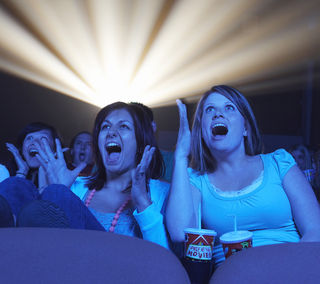Attention
The Tyranny of Film
How filmmakers use their craft to direct our attention
Posted July 27, 2016
By Joe Magliano and guest contributors Lester Loschky and Tim J. Smith
It’s movie season again, so what better time to discuss the psychology of film.

My colleagues Lester Loschky and Tim Smith have co-written this movie-themed blog. We have been collaborating together for several years because we’re all fascinated with how movies influence us psychologically and cognitively.
Over the past 100-plus years, the film industry has developed a set of editing and filming approaches to efficiently tell stories on the big screen. While any given movie may feel like its scenes flow as if they happened in the real world, the way in which a film is produced couldn’t be further from reality.
Feature films are made up of thousands of camera shots. Any scene can have hundreds of shots, but each could have been filmed at very different times and in different places. Filmmakers have developed strategies that allow them to tell a story across a series of shots in a way that they believe gives viewers the illusion of a continuous story happening in coherent space and time.
For example, a scene of two characters having a conversation could have involved filming each actor delivering lines in isolation from one another, but you edit them together, and the viewer perceives a conversation.
Our research has shown that these techniques may do more than just make the story clear. They also grab and direct the audience members’ attention in ways that profoundly change our psychological understanding of the storyline.
For example, cross cutting is a common technique used to help viewers predict what will happen next. Think of a car chase scene where the movie switches back and forth from the chase to a group of men carrying a pane of glass across the street. You just know that the cars will crash into the glass.
We demonstrated the effectiveness of cross cutting in a study (Magliano, Dijkstra, & Zwaan, 1996) that involved the James Bond movie, “Moonraker” (Broccoli, R. & Gilbert 1979). One 12-second-clip from the movie is helpful for illustrating how cross cutting works to help people make predictions.
Bond’s nemesis, Jaws, is shown falling through the air. He pulls the ripcord of his parachute, but it fails to open. Then the movie switches back and forth between shots of him continuing to fall and shots of a circus tent. When study participants were able to watch the scene in the context of the entire movie, 100 percent of them predicted what would happen next—that Jaws would plunge into the tent.
In a new study we published last year, we show that this idea of having our attention controlled by the movie is borne out in terms of how our eyes move across the screen but not necessarily in our comprehension of a scene.
We made a simple manipulation that changed the viewers’ experience in a dramatic way. Half of our study participants watched the entire three-minute scene leading up to the 12-second segment in “Moonraker”; the other half watched the 12-second segment without the full-scene context.
People who watched the entire scene leading up to the 12-second segment were much more likely to make an accurate prediction than those who only saw the critical segment.
In this study, we also were highly interested in the eye movements of audience members. We were interested in determining if they would be different between the groups. We thought they could be because our manipulation changed how the two groups understood the film. It is well established that eye movements are very different between a group of readers who understand what they are reading and a group that does not.
Would this be the case with movies?
So, as the 12-second segment unfolded, we used a device to track audience members’ eye movements across the screen.
The eye movements of the two groups were virtually identical, even though members of one group lacked context and didn’t understand the segment in the same way. We call this phenomenon the “tyranny of film.”
How does this tyranny happen?
Filmmakers typically want to make it easy for us to process a movie, so they do things that attract our eyes to the exact regions of the screen where the action is happening.
The techniques filmmakers use to guide our eyes include many aspects of a film’s production. A director, for example, will stage a scene so that the actors don’t overlap in their performances. That way viewers can clearly shift their attention between the key events.
A director of photography (or cinematographer) will design a shot so that the framing, lighting and depth of field (how blurry the background is relative to the sharp foreground) all direct attention to the most important object in each image. The director of photography will also move the camera so that actions such as an actor’s head-turn, a punch, or leaving the frame cues attention to what will happen next.
The editor can then use these cues to direct our attention to new content across a cut or a series of shots. By choosing close-up shots that show the key points of an event sequence (such as Jaws flapping mid-air and then crashing into the circus tent), the editor can even de-emphasize space and time without the viewer even noticing.
All of these members of the film crew (and many more not mentioned) have an intuitive insight into how viewers attend to the final audiovisual experience created by a film.
However, our research shows that knowing where viewers look does not guarantee that a filmmaker knows what the audience is thinking.
This mismatch between attention and comprehension is one of the powers of cinematic storytelling. It ensures that members of an audience can simultaneously have a powerful shared experience of gasping, screaming, or laughing, while also taking away a uniquely personal view of the narrative from the film.
So, next time you feel your attention glued to the screen, you might think of all the skill used to create such tyrannical control of your attention. But you can rest assured—for the most part—that filmmakers only have our best interests in mind. By showing us where to look, we can devote our energies to enjoying the show (or not) in our own way.
NOTE: If you’re interested in learning more about the art of filmmaking, Bordwell and Thompson’s “Film Art: An Introduction” (2016), is a great place to start. For more details of film cognition and how filmmakers use their craft to grab our attention, check out Tim J. Smith’s theory and review in the journal Projections (2012).
Joe Magliano, Ph.D., is a professor of psychology at Northern Illinois University. He teaches courses about cognitive psychology and the psychology of language. His research focuses on how we understand narratives across different media (text, film, graphic narratives) and how we can help struggling readers.
Lester C. Loschky, Ph.D., is an associate professor of psychological sciences at Kansas State University. His work is concerned with visual cognition and scene perception, from both a perceptual and a cognitive viewpoint, and its real world applications. His research emphases are on the relationships between eye movements, attention, and higher-level cognitive processes, with applications in human-computer interaction (HCI), computer-assisted instruction (CAI), and educational applications of better understanding the processes involved in visual narrative perception and comprehension.
Tim J. Smith, Ph.D., is a reader in the Department of Psychological Sciences at Birkbeck, University of London. He teaches cognitive psychology and advanced research methods. His research focuses on how we process audiovisual scenes in real-life, the lab, virtual reality and media. He has specific interest in understanding how filmmakers have intuited the way we see the world and exploit this to craft our experience at the movies.
References
Bordwell, D. & Thompson, K. (2016). Film Art: An Introduction. New York: McGraw-Hill.
Broccoli, A. R. P., & Gilbert, L. D. (1979). Moonraker [Film]: Available from CBS/Fox Video, Industrial Park Drive, Farmington Hills, MI 48024.
Loschky, L.C., Larson, A.M., Magliano, J.P., & Smith, T.J. (2015). What would Jaws do? The tyranny of film and the relationship between gaze and higher-level narrative film comprehension. PLoS ONE 10(11): e0142474. doi:10.1371/journal.pone.0142474
Magliano, J. P., Dijkstra, K., & Zwaan, R. (1996). Generating predictive inferences while viewing a movie. Discourse Processes, 22, 199-224.
Smith, T. J. (2012) The Attentional Theory of Cinematic Continuity, Projections: The Journal for Movies and the Mind. 6(1), 1-27.




